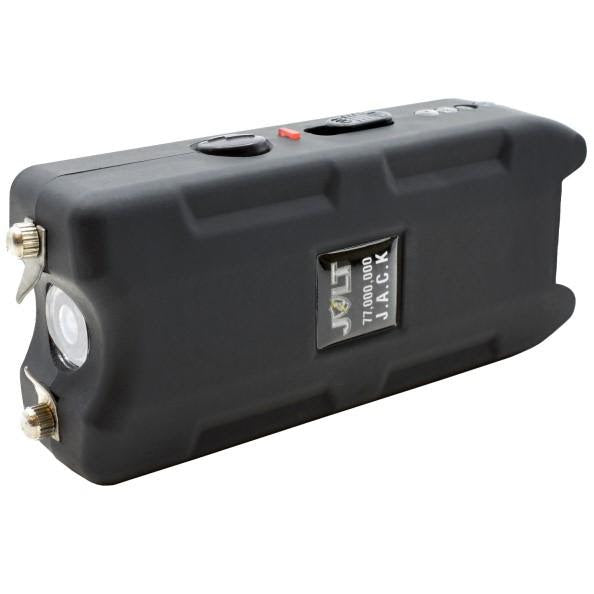How Does a Stun Gun Work?
Everyone should know how to defend themselves as it’s a critical survival skill. Of all the self-defense tools available on the market, TASERs® and stun guns are some of the most popular and effective weapons. But many people don’t know the difference between TASERs® and stun guns or how they work. So here is everything you need to know about what stun guns are and how they work.
Quick History of Stun Guns
It may surprise you, but stun guns have been around in some capacity since the 1700s. Pieter van Musschenbroek, a Dutch Physicist, and German inventor Ewald Georg von Kleist created the Leyden jar independently from each other. Kleist invented it in 1745, and Musschenbroek created his version in 1746.
It was a glass jar partially filled with water and corked. The cork was penetrated by a nail or wire that dipped into the water. You charged the jar by contacting the exposed end of the nail or wire with some type of friction device that created static electricity. You could demonstrate a charge by touching the nail or wire with your hand and break the contact, which would shock you.
Many early electrical experiments were conducted using the Leyden jar, which was fundamentally important to the study of electrostatics. This invention was the first way to collect and preserve electrical charges in large quantities that scientists could discharge at their will. The Leyden jar overcame the previous limitations to early research and study of electrical conduction.
We may never have had stun guns in the future without the early electrical studies the Leyden jar allowed. Fast forward hundreds of years later to the cattle prod, the first product that used electricity as a non-lethal means of using electric shock to control animals. Many ranchers still use cattle prods today to move livestock.
The first actual version of the stun gun was the stun glove, where electricity ran into a glove through a tube. It was invented sometime in the 1930s but didn’t become widely used. The TASER® was invented in the 1960s when stun guns became a popular self-defense weapon. U.S. Marshals used the early TASERs® to subdue out-of-control prisoners on airplane flights.

Since then, the original TASER® was invented; its modern counterparts have become the most popular self-defense weapons anywhere because they are affordable, effective, and non-lethal.
Your Body’s Electrical System
The biggest reason that makes the stun gun so effective is how it interacts with the body’s electrical system. TASERs® and stun guns each affect the body differently. But first, the body’s electrical system.
People tend to view electricity as harmful because being struck by lightning or sticking your finger in an electrical outlet can kill you. But smaller amounts of electricity won’t hurt you, and it actually plays a critical role in the body. All your nerves fire with electrical signals.
For instance, if you want to drink a glass of water, your brain will send an electrical signal to a nerve cell toward the muscles in your arm. The signal tells the cell to release a neurotransmitter, known as a communication chemical, to the muscle cells. This neurotransmitter tells the muscles to expand or contract in the ways necessary for your arm to move to bring the glass of water to your mouth.
Once you pick the glass up, the sensitive nerve cells send an electrical signal to the brain that tells you what the glass feels like in your hand. It really is an amazing process.

Disrupting the Nervous System
The whole idea behind a stun gun is that it disrupts this whole communication process. Stun guns generate a low amperage, high-voltage electrical charge that disrupts the electrical system in your body. Put simply, the charge doesn’t have much intensity, but there is a lot of pressure behind it.
When you stun an assailant, the high voltage allows a charge to pass through their skin and clothing. But at three milliamps, the charge isn’t intense enough to damage the attacker’s body unless you apply the stun gun for an extended period.
The charge confuses the person’s nervous system and causes a few other things to occur. First, the charge combines with the electric signals coming from your assailants’ brain and mixes it with noise, so it’s more difficult for their body’s muscles to move. This charge temporarily partially paralyzes them.
If the current is generated by a pulse frequency, then it imitates the body’s electrical signals. If this is the case, then the current may tell the assailant’s muscles to work a lot in a short timeframe. However, it doesn’t direct that work to any specific movement. These signals will leave your attacker too weak to move because it depletes their energy reserves.

Neuromuscular Incapacitation
The reason why TASERs® are so popular is they impact the sensory nerves and motor nerves, causing neuromuscular incapacitation (NMI). These are through the electrical pulses mentioned above. The TASER® causes involuntary stimulation of both the motor and sensory nerves that interferes with the assailant’s ability to use the affected muscles.
Traditional stun guns work with pain compliance only and therefore do not affect an attacker with high pain tolerance like a drug user. But the TASER® causes pain and incapacitates an attacker. However, NMI depends on whether probe spread is sufficient, if it’s within close enough proximity to close a circuit, and if the circuit is maintained.
Volts vs. Amps
Many people aren’t aware of the difference between volts and amps, so let's start there. Voltage is the measure of the pressure that allows the flow of electrons, while amperage is the volume of electrons.
Voltage is a measure of how much potential energy something has. It doesn't matter what kind of voltage we're talking about: AC or DC; it all measures in volts. For instance, the TASER® fires at 50 thousandths (0.05) of an amp, but the TASER® XREP uses about 13 milliamps (0.013 amps).
TASERs® and TASER® XREPS are both designed to cause pain in addition to their electrical current. But the TASER® is not going to knock someone out unless they're hit on the head with it.
This voltage chart explains more about stun guns and TASER® voltages.

Electrodes
A typical TASER® will fire two electrodes, one from each side. The TASER® XREP projectile is designed to be shot remotely with a TASER® XREP Launcher, and it explodes on contact, firing up to ten small darts into the target.
Target Zone for TASERs®
TASERs® can be very painful, and they work in a couple of different ways. One is by shooting two electrodes into the victim's skin from each side about an inch apart. The other way is called drive stun, where you take off the cartridge and drive the probes directly into the assailant's body, similar to how stun guns work.
The best part is that the electrodes allow you to affect a larger portion of muscles, depending on their spread. Any part of the body becomes a great target because of the way TASERs® affect the human body.
Different Types of Stun Guns and TASERs®
Here are the most popular stun guns and TASERs® available now. Note some are for law enforcement use only.

Standard Stun Gun
We have the best TASER® for sale, and they can truly protect your loved ones in the event of an intruder. But self-defense stun guns can be a good alternative to TASERs®, too. They come in multiple shapes and sizes, such as keychain stun guns. These work solely on an electrical current that disrupts your body's system and causes you to lose control of muscles in the area where it is applied. It works the neuromuscular system mentioned previously.
Stun Belt
You can also use stun belts to immobilize someone, and they are mostly used in the prison system to control prisoners during transport and court proceedings. The belt itself is woven with thousands of volts capable of sending a charge through the person's body.
A correctional officer carries a remote control that operates the belt making it easy to activate the belt. If an inmate acts out, the belt delivers a high voltage charge to the kidneys.

Stun Baton
Stun batons allow an extended reach compared to stun guns. They are durable and lightweight, making them easy to hold and use, and they make great defense weapons against animals and people. Stun batons allow you to put some extra distance between you and your assailant and that extra space gives you an advantage.
TASER® Shot Gun
It shoots TASERs® at up to 50 yards away and has the ability to charge those TASERs® with heavier cartridges, giving them more power and range. It can be a great help with subduing large animals like a cow that has escaped the stock sale and threatens people in a downtown area. And since it isn’t lethal, it doesn’t kill the animal.
TASER® XREP Projectile
This projectile was designed for law enforcement who need help with large groups of people. TASER® XREP's are designed to cause pain in addition to their electrical current, and they're more of a shotgun than regular TASERs®. It explodes on contact and shoots out up to 10 barbs so you can hit more people in crowd control situations.
Liquid Stun Guns
One of the newest self-defense weapons is the liquid-filled TASER®. This TASER® allows you to tase an assailant from further away than a regular TASER® without making contact with them at all. These devices work the same as standard TASERs®, except they use a liquid stream instead of wires.
These are all great self-defense options, but can everyone carry a TASER®? It depends on your state and local laws.
Check Your State’s Laws and Regulations
Your state may have laws or regulations governing the use of stun guns, so it is important to check your particular area before purchasing one. There can be stiff penalties for having a TASER® illegally in areas with regulations against them.
Final Thoughts
Stun guns and Tasers are great options for self-defense; just make sure you check with state and local laws before you buy one. These less-lethal self-defense weapons have taken protection to a whole different level by incapacitating an assailant so you can get away.
FAQs
What is the difference between a TASER® and a stun gun?
A TASER® is designed to disrupt the electrical system of the human body. Stun guns deliver painful jolts that cause temporary loss of balance and muscle control without affecting heart rate or respiration. A TASER® also works from a distance up to 15 feet away, while stun guns can only work in close quarters.
What is the difference between a cattle prod and a stun gun?
Both cattle prods and stun guns deliver electrical current through two electrodes, but cattle prods were designed to keep an animal moving and shock only where they come in contact.
Do I need a license to carry a stun gun?
Although one does not need a license to carry a stun gun like a firearm, some states have certain laws and regulations that prohibit them. Check your local laws before considering your purchase.

